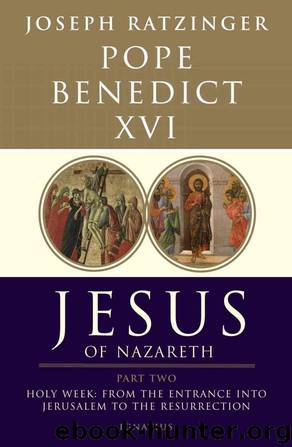Jesus Of Nazareth Part Two by Pope Benedict XVI

Author:Pope Benedict XVI [XVI, Pope Benedict]
Language: eng
Format: epub
Tags: Spiritual & Religion
ISBN: 9781586175009
Publisher: Ignatius Press
Published: 2011-03-10T05:00:00+00:00
4. Jesus’ Prayer on the Mount of Olives in
the Letter to the Hebrews
Finally we must turn our attention to the passage from the Letter to the Hebrews that points toward the Mount of Olives. There we read: “In the days of his flesh, Jesus offered up prayers and supplications, with loud cries and tears, to him who was able to save him from death, and he was heard for his godly fear” (5:7). Here we may identify an independent tradition concerning the Gethsemane event, for there is no mention of loud cries or tears in the Gospels.
We have to admit that the author of the Letter is clearly not referring exclusively to the night in Gethsemane, but has in mind the whole of Jesus’ via dolorosa right up to the crucifixion, that is to say, to the moment when, according to Matthew and Mark, Jesus “cried out with a loud voice” the opening words of Psalm 22; these two evangelists also tell us that Jesus expired with a loud cry; Matthew expressly uses the word “cried” at this point, meaning “cry out” (cf. 27:50). John speaks of Jesus’ tears at the death of Lazarus, and this in the context of his being “troubled” in spirit—for which, as we have seen, John uses the word that was to reappear in the “Palm Sunday” passage corresponding to the Mount of Olives tradition.
Each time, it is a question of Jesus’ encounter with the powers of death, whose ultimate depths he as the Holy One of God can sense in their full horror. The Letter to the Hebrews views the whole of Jesus’ Passion—from the Mount of Olives to the last cry from the Cross—as thoroughly permeated by prayer, one long impassioned plea to God for life in the face of the power of death.
If the Letter to the Hebrews treats the entire Passion as a prayer in which Jesus wrestles with God the Father and at the same time with human nature, it also sheds new light on the theological depth of the Mount of Olives prayer. For these cries and pleas are seen as Jesus’ way of exercising his high priesthood. It is through his cries, his tears, and his prayers that Jesus does what the high priest is meant to do: he holds up to God the anguish of human existence. He brings man before God.
There are two particular words with which the author of the Letter to the Hebrews underlines this dimension of Jesus’ prayer. The verb “bring” (prosphérein: bring before God, bear aloft—cf. Heb 5:1) comes from the language of the sacrificial cult. What Jesus does here lies right at the heart of what sacrifice is. “He offered himself to do the will of the Father”, as Albert Vanhoye comments (Let Us Confidently Welcome Christ Our High Priest, p. 60). The second word that is important for our purposes tells us that through his sufferings Jesus learned obedience and was thus “made perfect” (Heb 5:8-9). Vanhoye points out that
Download
This site does not store any files on its server. We only index and link to content provided by other sites. Please contact the content providers to delete copyright contents if any and email us, we'll remove relevant links or contents immediately.
Signature in the Cell: DNA and the Evidence for Intelligent Design by Stephen C. Meyer(2879)
Real Sex by Lauren F. Winner(2873)
The Holy Spirit by Billy Graham(2782)
The Secret Power of Speaking God's Word by Joyce Meyer(2759)
The Gnostic Gospels by Pagels Elaine(2402)
Jesus by Paul Johnson(2232)
Devil, The by Almond Philip C(2207)
23:27 by H. L. Roberts(2144)
The Nativity by Geza Vermes(2119)
Chosen by God by R. C. Sproul(2058)
All Things New by John Eldredge(2052)
Angels of God: The Bible, the Church and the Heavenly Hosts by Mike Aquilina(1871)
Angels by Billy Graham(1845)
The Return of the Gods by Erich von Daniken(1843)
Knowing God by J.I. Packer(1727)
Jesus of Nazareth by Joseph Ratzinger(1710)
Evidence of the Afterlife by Jeffrey Long(1707)
The Gnostic Gospel of St. Thomas by Tau Malachi(1682)
How To Be Born Again by Billy Graham(1673)
